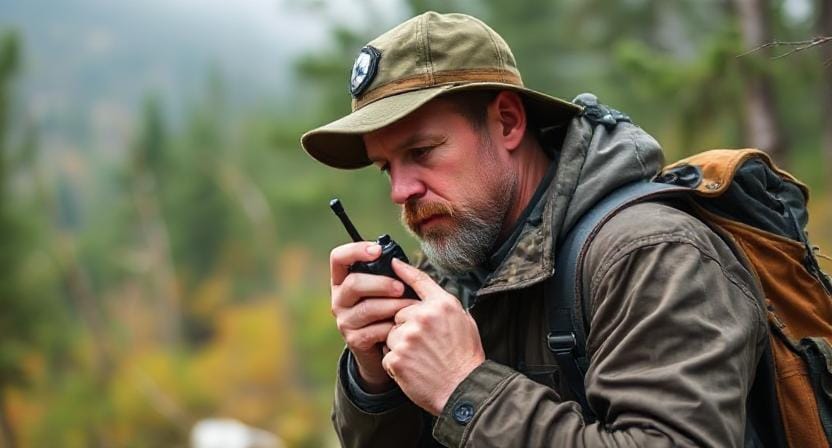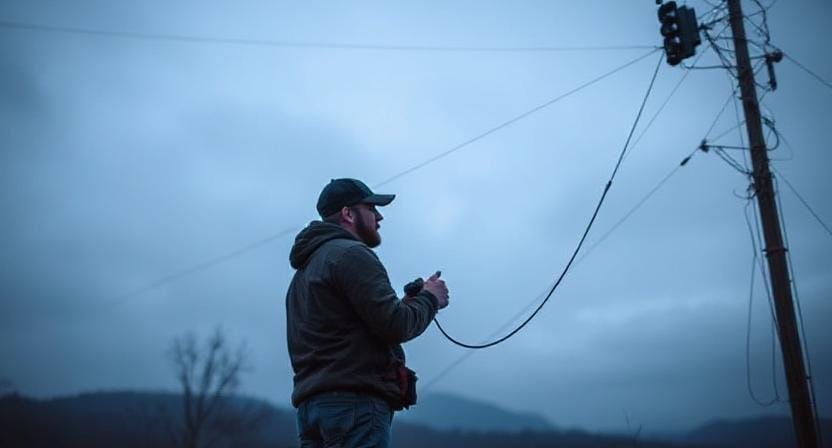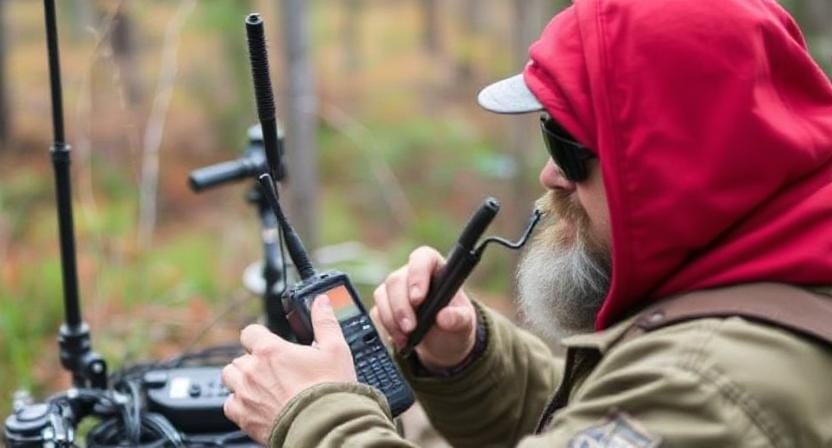Please Note: This post may contain affiliate links. If you click one of them, we may receive a commission at no extra cost to you. As an Amazon Associate, I earn from qualifying purchases.
Last Updated on October 19, 2025 by Kevin Collier

Top Takeaways and Key Concepts
- Choose the right radio type: Pick walkie-talkies for short range or ham radios for distance.
- Get licensed if required: Obtain a ham radio license before broadcasting on regulated frequencies.
- Form a prepper network: Assign roles, schedule check-ins, and keep communication consistent.
- Prepare reliable gear: Use quality radios, strong antennas, and backup power sources like solar chargers.
- Practice communication drills: Test signals, refine codes, and update procedures for real emergencies.
Picture this: you're in your bunker, cozy but kind of cramped. Canned beans everywhere. And that toilet paper mountain is looking a bit shaky. You smile nervously, thinking, “What if I want to talk to my friends?” When the internet’s gone and phones are just fancy paperweights, what do you do?
No need to panic! Setting up a radio communication network could be the hero we all need. It’s not as tricky as it sounds. Just like baking cookies—kind of! Grab a few hand-held radios, and you’re halfway there.
Imagine chatting with your neighbor while keeping your eye on the beans. “Hey, I’ll bring dessert to the next meeting! Who’s bringing the chips?” It keeps everyone connected and ready. Plus, it’s nice to hear familiar voices when things get rocky. You know?
Think about tracking down a nice spot for a potluck, too. Everyone loves food, right? You could even make it a fun event. Get the kids involved. Maybe have a little practice session on how to use those radios. They’ll love it, and it'll keep their spirits up.
Setup can feel overwhelming. Just take it one step at a time. Start simple! Find a good spot with no interference. Test them out while you’re relaxing. You’ll soon feel like a pro, like you’re in your own little secret club.
Being prepared makes everything feel a bit safer. It’s about community connection, not just beans and toilet paper. So grab those radios. Let’s get this party started! You’ll be the coolest prepper around, discussing snacks and plans like you’re planning a family reunion. Who knew prepping could be fun?
Understanding Radio Basics

Let's start with some basics before we get right into the deep end of radio transmission. What is a radio, really? It's not only that obnoxious box that plays oldies when you're trying to find your favorite songs; it's also a lifesaver in an emergency!
*** Shop for Survival Gear - Tools - Kits ***
Survival Gear - Bags and Backpacks - Knives - Boots/Footwear - Communication
Outdoor Cooking - Gloves - Hydration - Dry Boxes - Water Filtration Systems
Tents - Sleeping Bags - First Aid Kits - Multi-Tools - Flashlights - Fire Starters
Navigation - Survival Food - Night Vision - Headlamps - Stun Guns - Binoculars
1. Different kinds of radios: There are a lot of different kinds of radios, like walkie-talkies, ham radios, and even CB radios, which I suppose stands for “Can't Believe People Still Use These.” Choose thoughtfully based on your demands because each variety has its own benefits and cons.
For instance, walkie-talkies work well for talking to people who are close by, but they might have trouble talking to those who are far away, like my grandma attempting to figure out how to use modern technology.
2. Licensing Requirements: You could require a license depending on what kind of radio you choose. Yes, people, filling out documents and waiting for approval from the government is the best way to show that you're ready!
Because of the power they utilize and the frequencies they use, ham radios usually need a license. Before you start sharing your secret recipe for apocalypse chili, be sure you know the rules.
3. Picking Frequencies: After you get your license (or if you choose an unlicensed option), you'll want to pick the frequencies that work best for your organization. Also, don't use emergency frequencies unless it's a true emergency. No one wants to hear about Aunt Edna's cat stranded in a tree during a crisis!
How to Set Up Your Network

It's time to set up your network now that we know the basics of radio. This is like making an invisible web that connects all of your survivalist buddies without using any yarn or sticky notes.
1. Getting Your Team Together: First, find other preppers who have the same goals and interests as you. After all, it's more fun to survive with friends (plus they generally have munchies). Make sure everyone knows how important it is to check in regularly and obey the rules.
2. Assigning Roles: Give each member of your team a distinct job depending on their abilities and interests. For example, one person may be in charge of keeping the equipment in good shape, while another could be in charge of coordinating messages (no pressure!).
To be honest, it helps keep things in order; otherwise, things go out of hand faster than my kids' room after five minutes.
3. Setting up times to check in: Regular check-ins will make sure that everyone knows about crucial updates or changes to plans, and they'll offer you a chance to show off your new antenna arrangement! Just make sure no one gets too carried away talking about last night's supper; when lives are at stake, it's important to keep things short.
Necessary Equipment

Okay, then! Let's speak about gear because every smart prepper knows that it's not just about having entertaining chats across crackly airwaves; it's also about having gear that works.
1. Radios: Buy good radios that fit your demands; don't cut corners here! You should look for features like weather warnings (you never know when tornadoes will show up) or batteries that can be recharged. No one wants to have dead batteries during the end of the world.
2. Antennas: A decent antenna may make the signal much stronger. You want one that works well but doesn't appear like it belongs in a sci-fi movie. Depending on where you'll be utilizing them most often, you might want to think about dipole antennas or vertical antennas.
3. Power Sources: Don't forget to have backup power sources! When calamity strikes, it's important to have more than one way to keep things operating smoothly. Solar chargers and hand-crank generators (yes, they exist) are two examples. And trust me, nothing kills morale faster than dead electronics!
Protocols for Communication
Congratulations! You've got everything ready now. But before you rush into action like superheroes ready to save the world from boredom (or anything else), let's talk about how to communicate.
1. Making Codes: To keep conversations private between group members and avoid confusion over names (“Is Bob coming?” “Which Bob?”), come up with code terms or phrases that only your group knows, like naming pizza delivery “Operation Cheese.”
2. Message Structure: Make sure your communications are clear and to the point so that everyone understands them without needing an interpreter with flashcards on hand. A basic structure can go a long way here!
3. Emergency Procedures: Lastly, make plans for catastrophes like natural disasters or other crises where swift action is most important. For example, instead of yelling incoherently into thin air, use designated codes to transmit distress signals.
Testing Your System
It's time to test once everything is set up and everyone feels good about their new gadgets (yes, I mean both radios and munchies!).
1. Do drills: Set up frequent drills where team members practice talking to each other in different situations. It may sound serious, but it can be entertaining if done well! You might also have some friendly competition amongst groups. The group that wins gets to choose dessert first at next week's meeting!
2. Check Performance: After each drill, everyone gives each other high-fives (or maybe even some dramatic reenactments). Then, as a team, talk about what went well and what could have been better throughout the drills. This will help you get better at future operations over time!
3. Make Changes as Needed: Finally, remember that being flexible is important. If problems come up, make the necessary changes to make sure everything goes smoothly, whether the storms are metaphorical or real ones brought by Mother Nature herself causing havoc outside our doors again soon enough…
Suggested Resources:
Understanding Radio Communications
https://www.arrl.org/understanding-radio-communications
Getting Started with Ham Radio
https://www.hamradiopreparedness.com/getting-started-ham-radio
Emergency Preparedness Using Radios
https://www.redcross.org/get-help/how-to-prepare-for-emergencies/types-of-emergencies/radio.html

Kevin Collier is a seasoned survivalist and expert in prepping and homesteading, contributing to WiseSurvive.com. With a deep-rooted passion for self-sufficiency and outdoor survival skills, Kevin shares practical advice, strategies, and resources to help individuals prepare for any challenge. His informative articles cover a range of topics, from essential survival techniques to sustainable living practices, empowering readers to thrive in any situation. Whether you're a novice or a seasoned prepper, Kevin's insights will inspire you to take charge of your readiness and build resilience for the future.




